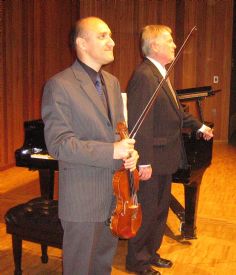|
Symphony
SRS SEASON ENDS WITH RESOUNDING TA-TA-TA-BANG
by Terry McNeill
Sunday, June 1, 2025
Symphony
YOUTHFUL VIRTUOSITY ON DISPLAY AT USO'S MAY CONCERTS
by Peter Lert
Saturday, May 17, 2025
Symphony
MYSTICAL PLANETS AND LIVELY GERSHWIN ORTIZ AT FINAL SRS CONCERT
by Peter Lert
Sunday, May 4, 2025
Symphony
VSO'S CONCERT MUSIC OF TIME, MUSIC OF PLACE
by Peter Lert
Sunday, April 27, 2025
Choral and Vocal
VOCAL ELEGANCE AND FIRE AT THE 222'S RECITAL APRIL 26
by Pamela Hicks Gailey
Saturday, April 26, 2025
CANTIAMO SONOMA SINGS AN INSPIRED GOOD FRIDAY MOZART REQUIEM CONCERT
by Pamela Hicks Gailey
Friday, April 18, 2025
DRAMATIC SHOSTAKOVICH SYMPHONY CLOSES PHILHARMONIC'S 25TH SEASON
by Terry McNeill
Sunday, April 13, 2025
LARGE COLLEGE OF MARIN AUDIENCE GREETS STOPHER ARTISTRY
by Terry McNeill
Saturday, April 5, 2025
Chamber
FRISSON DELIVERS SHIVERS OF DELIGHT
by Abby Wasserman
Sunday, March 30, 2025
OLD AND MOSTLY NEW IN SRS MARCH CONCERT IN WEILL
by Peter Lert
Saturday, March 22, 2025
|
 |
 Jassen Todorov and William Corbett-Jones In Newman Auditorium Oct. 31 |
TODOROV AND CORBETT-JONES PERFORM DRAMATIC THREE-SONATA RECITAL IN NEWMAN
by Terry McNeill
Sunday, October 31, 2010
After a long dry spell Sonoma County seems to be seeing a flood tide of fine violin playing. David McCarroll, Roy Malan, Michael Ludwig and Vadim Gluzman have played recent concerts, and San Francisco State University Professors Jassen Todorov and William Corbett-Jones continued the trend in a dramatic recital Oct. 31 in SRJC’s Newman Auditorium for the Concerts Grand series.
Before an audience of 112, sprinkled with string players, Tartini’s G Minor Sonata (Devil’s Trill) launched the program. It’s a walk in the park for the piano part but technically demanding for the violin. Mr. Todorov handled the long cadenza, penned by Fritz Kreisler, with aplomb and plenty of trills of varying speeds and intensity. The Andante was especially effective, its repose needed from the restless nature of the work. There isn’t much for the piano to do here but Mr. Corbett-Jones, a long-time favorite for audiences in Santa Rosa, ably contributed the continuo line.
Things changed with Respighi’s brawny Sonata in B Minor, rarely heard and a composition that was received with anticipation by many, as only the Heifetz-Bay recording from 1950 has gained any notice, at least compared with contemporary sonatas by Strauss, Busoni, St. Saens and Elgar. Composed in 1917 and reflecting the carnage of World War I, the Sonata is a dark odyssey, bright at times but ultimately a sad travail with vocal lines in high string registers and rumbling tremolos and rapid left-hand passages for the pianist. Mr. Todorov was up to the demands of the writing, taking judicious tempos in each of the three movements, his not large but fully penetrating tone carrying throughout Newman’s less-than-reverberant acoustics. The lovely Andante Espressivo was played in the Romantic vein but also impressionistically, the violinist deftly phrasing the music and mirroring the piano line. In the concluding Passacaglia the performers had difficulty staying together, the necessary momentum slipping away before Mr. Corbett-Jones’ descending double octaves brought the Sonata to a rousing end. Mr. Todorov, with a powerful F Sharp-D-B passage, graciously gave the last sound to his partner. It was a performance that wasn’t ready for a microphone but still elicited a standing ovation and the assembly knowing it had heard a trenchant violin work of prismatic passion.
Order was restored after intermission with the famous Beethoven A Major Sonata, Op. 47 (Kreutzer), a performance that found both musicians on familiar ground. This is a Sonata played by every virtuoso violinist, the two propulsive outer movements framing a quiet Andante con variazoni in the placid key of F Major. The duo had plenty of frenzied competition in the opening Adagio Sostenuto – Presto, Mr. Todorov’s bow often slashing in figurations and digging deep into the stormy sections.
The finale was performed in a more playful and generous mode, the accents telling and sharply opposed to the heroic nature of the first movement. In summary, this is a radical work, written in 1803 with the Eroica Symphony, and Messrs. Todorov and Corbett-Jones made the most of the Sonata’s architecture, underscoring the rhetoric without opting for a reading that would fill a larger hall.
Two encores were offered, the second a "perpetuum mobile" performance of François Schubert’s (1808 - 1878) innocuous “L’Abielle” (The Bee), redolent with Mr. Todorov’s speedy left-hand slurred crossings. However, it was the first encore, Tchaikowsky’s melancholy “Melody in E” from the Brailovo Suite, that generated rapt silence in the hall. It was Oistrakh’s encore in his American debut recital, and here as in 1955 there were not many dry eyes in the house.
The reviewer is the producer of the Concerts Grand series
|

